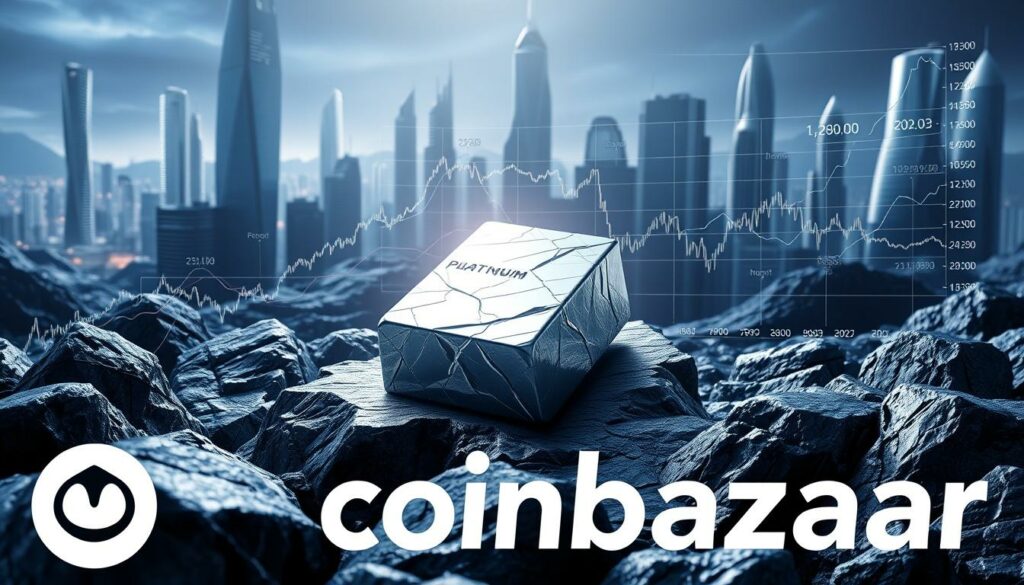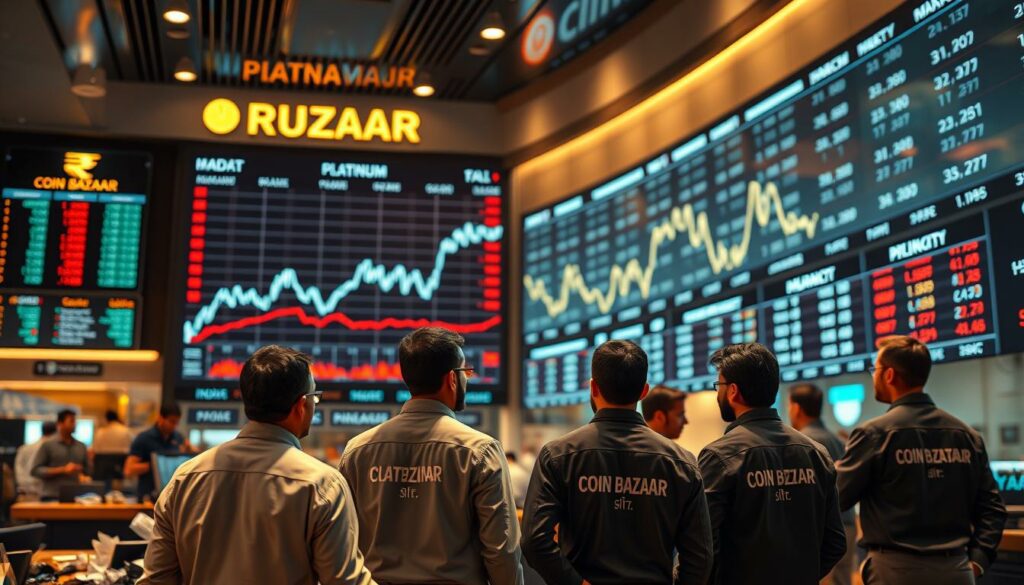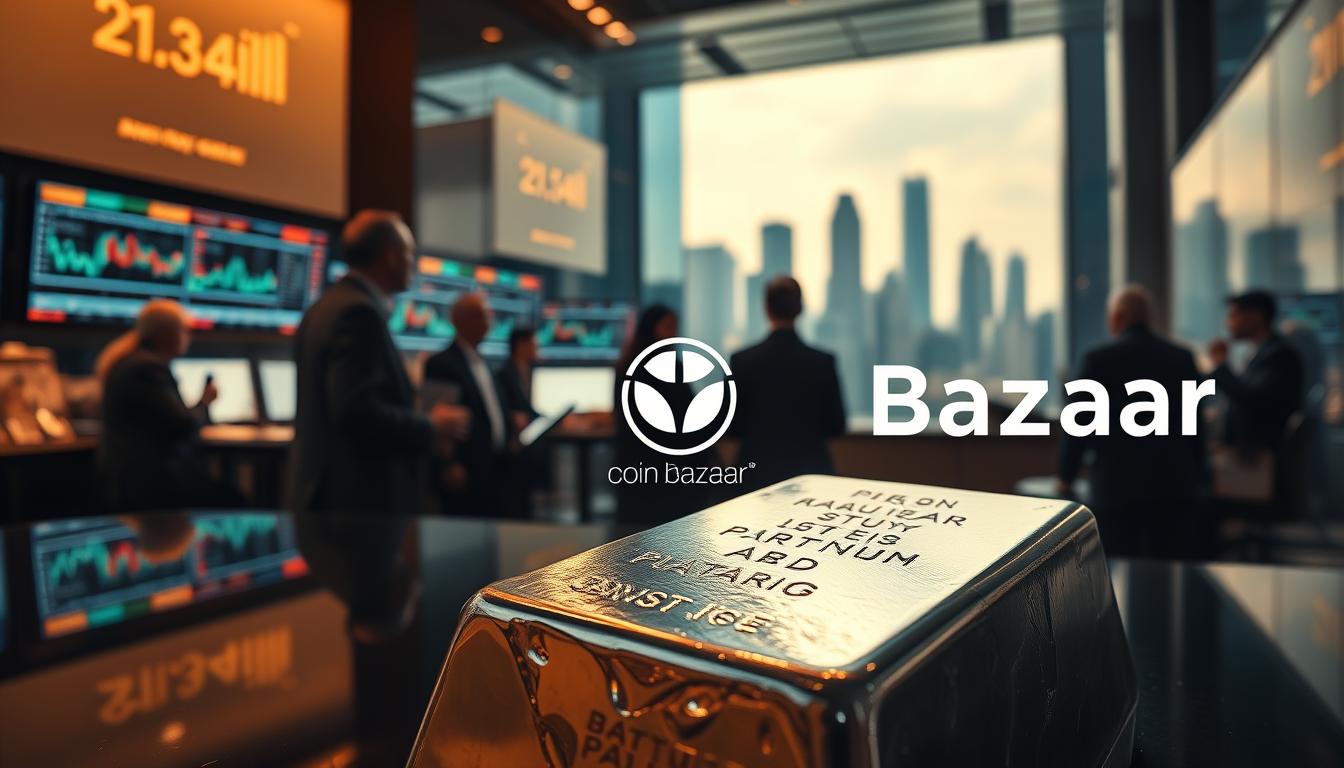Exclusive Deals & Trending Items
Understanding the future of platinum supply and demand is key for smart investment choices. This knowledge helps you navigate the precious metals market.
The World Platinum Investment Council (WPIC) publishes reports on platinum market trends. These reports offer deep insights into the platinum market’s current state and future outlook.
According to the WPIC’s latest report, the platinum market will likely stay in deficit until 2029. It’s vital to keep an eye on the platinum price forecast for this reason.
Key Takeaways
- The platinum market is expected to remain in deficit through 2029.
- Understanding platinum supply and demand is crucial for investment decisions.
- The WPIC’s reports provide valuable insights into platinum market trends.
- Staying informed about the platinum price forecast is essential.
- The future of platinum supply and demand will significantly impact the market.
Current State of the Global Platinum Market
Recent changes in the global platinum market have caused a notable deficit. Looking at the current scene, we see big shifts in supply and demand.
Key Market Indicators and Metrics
The platinum market saw a deficit of almost 1 Moz in 2023, the Platinum Quarterly report shows. Total supply was up 3% in 2024, showing a short-term market adjustment. But, it’s expected to drop by 4% in 2025, hinting at tighter supply.


Recent Market Developments
The market has seen many changes affecting its current state. Supply chain dynamics and production levels play big roles in shaping the market’s path. Experts say, “The platinum market’s future depends on its ability to adjust to changing demand and supply limits.”
“The shift towards greener technologies and stricter emission controls continues to drive demand for platinum in the automotive sector.”
This demand, along with expected supply cuts, will likely have big effects on the market’s future.
Historical Overview of Platinum Markets
The platinum market has shown trends and patterns over the years. These are key to predicting future market changes. Looking at historical data on platinum supply and demand gives us valuable insights.
Supply and Demand Patterns Over the Past Decade
In the last decade, the platinum market has seen big changes in supply and demand. The WPIC’s reports show a market deficit. This is mainly due to supply constraints and growing demand from the automotive sector. Experts predict this deficit will continue until 2029.
The table below shows the supply and demand trends in the platinum market over the past decade.
| Year | Supply (000 oz) | Demand (000 oz) | Balance (000 oz) |
|---|---|---|---|
| 2013 | 6230 | 6340 | -110 |
| 2022 | 5980 | 7120 | -1140 |


Price Fluctuations and Market Responses
Platinum prices have been all over the place. They’ve been affected by mining production levels, automotive demand, and investor sentiment. These price swings have led to changes in how the market operates.
It’s important to understand these historical price changes and market reactions. This helps us guess what the future might hold for the platinum market.
Primary Platinum Production Sources
It’s important to know where most platinum comes from. The world’s platinum supply mainly comes from a few countries.
South Africa’s Dominance in Platinum Mining
South Africa leads in platinum production, making up most of the world’s supply. The Bushveld Complex in South Africa is a huge platinum reserve. It’s key to the global platinum market.
Russia and Zimbabwe as Key Producers
Russia and Zimbabwe are also big in platinum production. Russia’s Norilsk Nickel and Zimbabwe’s Great Dyke are major sources. They’re crucial to the global platinum supply.
Emerging Production Regions
New areas are starting to add to the global platinum supply. Countries like Canada and the United States are finding new platinum deposits. This could change the global supply chain.
| Country | Platinum Production (Tonnes) | % of Global Production |
|---|---|---|
| South Africa | 120 | 70% |
| Russia | 25 | 15% |
| Zimbabwe | 15 | 9% |
| Others | 10 | 6% |
Platinum Supply Chain Dynamics
The platinum supply chain is a complex network. It includes mining to market access. Understanding these dynamics is key for effective market navigation.
Mining and Extraction Processes
Platinum mining is complex, involving extraction and refining. The extraction method greatly impacts costs and efficiency.
Open-Pit vs. Underground Mining Methods
Platinum can be mined in two ways: open-pit or underground. Underground mining is more common due to platinum’s depth. The choice affects costs and environmental impact.
Processing and Refining Techniques
After mining, platinum ore is processed and refined. Advanced techniques are needed for high purity levels. This is crucial for industrial and investment needs.
Distribution Channels and Market Access
Effective distribution channels and market access are crucial. They ensure platinum reaches end-users efficiently. The supply chain’s resilience depends on these factors.
Key channels include direct sales to manufacturers, jewelers, and investors. Market access is influenced by geopolitical stability and trade policies.
Supply Chain Vulnerabilities and Resilience
The platinum supply chain faces risks like geopolitical tensions and labor disputes. Building resilience is key to mitigate these risks.
Improving resilience involves diversifying sources, investing in technology, and better labor practices. A resilient supply chain can handle disruptions better, keeping the market stable.
| Supply Chain Stage | Key Activities | Challenges |
|---|---|---|
| Mining and Extraction | Open-pit and underground mining, ore processing | High costs, environmental impact |
| Processing and Refining | Concentration, smelting, refining | Technological complexity, energy consumption |
| Distribution and Market Access | Logistics, marketing, sales | Geopolitical risks, market volatility |
Recycling’s Growing Role in Platinum Supply
Recycling is becoming key in the platinum supply chain. It helps meet the growing demand from cars and jewelry. Understanding recycling’s role is important.
Recycling is crucial in the platinum market. Primary production faces challenges like deeper mining and lower ore grades. Recycling fills the gap with new technologies and awareness of its benefits.
Automotive Catalytic Converter Recycling
Used car converters are a big source of recycled platinum. They contain platinum group metals (PGMs) that can be reused. The process involves collecting converters, extracting PGMs, and refining them.
Johnson Matthey is a leader in recycling converters. They process thousands of tons each year, recovering lots of platinum and other PGMs.
| Year | Platinum Recovered (Tonnes) | Percentage of Total Platinum Supply |
|---|---|---|
| 2020 | 1.2 | 30% |
| 2021 | 1.5 | 35% |
| 2022 | 1.8 | 40% |
Jewelry and Electronic Waste Recovery
Jewelry and electronic waste are also important sources of recyclable platinum. Jewelry recycling involves refining used jewelry for reuse. Electronic waste, like old electronics, is another growing source.
“The recycling of platinum from electronic waste is becoming increasingly important as the world transitions to more sustainable practices.”
As recycling technologies get better and more people learn about its benefits, recycling’s role in the platinum supply chain will grow.
Automotive Industry: The Largest Platinum Consumer
The automotive industry is the biggest user of platinum. Its demand is shaped by emission rules and new car technologies. You might wonder how this affects platinum prices. Platinum is key in catalytic converters, which cut down vehicle emissions.
Catalytic Converters and Emission Standards
Catalytic converters are vital in cars with engines, cutting down harmful emissions. Stringent emission standards worldwide boost platinum demand. For example, Euro 6 in Europe and Bharat Stage VI in India need better converters, raising platinum needs.
Important points about catalytic converters and emission standards are:
- More efficient converters are needed for tighter emission rules.
- Platinum makes converters work better.
- Changing emission rules could change platinum demand.
Hydrogen Fuel Cell Vehicles and Platinum Demand
Hydrogen fuel cell cars also use platinum. The platinum catalyst is key for these cars’ electricity generation. As these cars become more common, so does the need for platinum.
Key points about hydrogen fuel cell cars and platinum demand are:
- Platinum is crucial in fuel cells.
- More platinum demand is expected as fuel cell tech improves.
- Trying to use less platinum in fuel cells without losing performance.
Electric Vehicles’ Impact on Platinum Usage
Electric vehicles (EVs) are changing how we use platinum. EVs don’t need catalytic converters, which could lower platinum demand. But, how much it changes will depend on EVs’ growth and new tech.
It’s important to understand how traditional cars, hydrogen cars, and EVs affect platinum demand. The future of platinum will be influenced by tech, rules, and market trends in the automotive world.
Jewelry Sector Demand Trends in India and Globally
Platinum jewelry is very important in India, not just for its value but also as a symbol of elegance. It’s seen as a sign of sophistication in Indian jewelry.
Cultural Significance in Indian Jewelry Market
In India, platinum jewelry is especially valued for weddings and ceremonies. It’s loved for its luxury and lasting quality.
Wedding and Ceremonial Platinum Jewelry
Platinum wedding jewelry is sought after for its durability and luxury. Platinum’s strength and rarity make it perfect for detailed designs that families treasure for years.
Urban vs. Rural Consumption Patterns
Urban places want more platinum jewelry because of global trends and more money to spend. But, rural areas prefer traditional gold and silver jewelry.
Global Jewelry Consumption Patterns
Worldwide, platinum jewelry demand changes with the economy, culture, and marketing. Some big trends are:
- More people want sustainable and eco-friendly jewelry
- Platinum jewelry is getting popular in new markets
- Online shopping for jewelry is on the rise
The demand for platinum in jewelry is influenced by many things. Cultural, economic, and marketing factors all play a part. Knowing these trends is key for those in the platinum market.
Industrial Applications Driving Platinum Demand
Platinum is a versatile and valuable metal. It plays a key role in many industries. You’ll see how platinum is used in different sectors, boosting demand and shaping the market.
Chemical and Petroleum Refining Industries
Platinum is vital in the chemical and petroleum sectors. It’s known for its catalytic abilities. It helps make nitric acid, key for fertilizers and explosives.
Also, platinum catalysts refine crude oil. This process creates high-octane gasoline and other products.
Medical and Biomedical Applications
In medicine, platinum is used in anticancer drugs and implants. Its biocompatibility and corrosion resistance make it perfect for medical devices. This includes pacemakers and dental implants.
Emerging Industrial Uses
New technologies are opening up more uses for platinum. For example, it’s being looked at for hydrogen production and fuel cells. These new uses are expected to increase platinum demand, making the platinum demand outlook positive.
Platinum’s wide range of uses shows its value beyond jewelry and investment. Its unique properties are crucial in many fields, from chemical refining to medical technology.
Investment Demand for Physical Platinum in Indian Markets
India is becoming a major player in platinum investment. More people are looking to add precious metals to their portfolios. This includes you, as you explore ways to diversify.
Investing in platinum is now easier than ever. Platinum bars and coins are widely available. They offer a real way to own this valuable metal.
Platinum Bars and Coins Availability in India
You can buy platinum bars and coins from trusted dealers and banks in India. There’s a wide range of products for all investment sizes. This makes it easier for more people to invest.
The popularity of platinum bars and coins comes from their easy purchase and the chance to own something real. This has helped increase platinum investment in India.
ETFs and Other Investment Vehicles for Indian Investors
You can also invest in platinum through Exchange-Traded Funds (ETFs) and other financial tools. These options let you invest in platinum without having to hold the metal physically.
ETFs and other investment vehicles offer diversification benefits. They can be traded on stock exchanges, making them liquid for investors like you.
Platinum Supply and Demand Balance Forecasts
The World Platinum Investment Council (WPIC) has made forecasts about platinum’s future. Knowing these forecasts is key for smart decisions in the platinum market.
Short-term Market Outlook (2023-2025)
In the short term, the platinum market is expected to be in deficit. The WPIC says this deficit comes from strong demand in the automotive and industrial sectors. Platinum’s use in catalytic converters will keep growing due to stricter emission rules worldwide.
Key Short-term Trends:
- Increasing demand for platinum in automotive catalytic converters
- Steady demand from the jewelry sector, particularly in India
- Growth in industrial applications, including chemical and petroleum refining
Long-term Projections (2025-2030)
Looking to 2025-2030, the WPIC predicts a continued deficit in the platinum market. This deficit is expected to average 689 koz pa from 2026 to 2029. The main driver is ongoing demand from the automotive sector, especially with hydrogen fuel cell vehicles.
| Year | Supply (koz) | Demand (koz) | Balance (koz) |
|---|---|---|---|
| 2025 | 6,500 | 7,000 | -500 |
| 2026 | 6,300 | 7,100 | -800 |
| 2027 | 6,200 | 7,200 | -1,000 |
| 2028 | 6,100 | 7,300 | -1,200 |
| 2029 | 6,000 | 7,400 | -1,400 |
When thinking about investing in or using platinum, these forecasts are crucial. The WPIC’s detailed analysis offers valuable insights into the platinum market’s future.
Price Forecast Scenarios for Platinum
Knowing how platinum prices might change is key for investors and industry folks. The World Platinum Investment Council (WPIC) offers deep insights into platinum price forecasts. This helps you understand market trends.
Many things affect platinum’s market, like supply and demand, global events, and new tech. Looking at different forecast scenarios helps grasp potential future price shifts.
Bullish Case Analysis
A bullish outlook for platinum prices comes from rising demand, especially in the car industry. Strong growth in emerging markets and a possible shortage in platinum supply could push prices up. Key things to watch include:
- More use of hydrogen fuel cell tech
- Tighter emission rules worldwide
- Challenges in mining that cut supply
Bearish Case Analysis
A bearish outlook might happen if demand drops or supply goes up. Advances in tech that cut platinum use in cars or more recycling could lower prices. Other risks include:
- Slow adoption of hydrogen fuel cell cars
- More platinum from recycling and new mines
- Global economic downturns hurting demand
Most Likely Price Trajectory
The most likely path for platinum prices balances these factors. The WPIC says a moderate demand increase with steady supply is expected. Expect prices to rise with growing demand from cars and industry. But, growth might slow due to supply chain issues and tech changes.
Geopolitical Factors Affecting the Platinum Market
Exploring the platinum market reveals a big role for geopolitical factors. These factors shape the market, affecting trends. They include mining rules, labor issues, and international trade policies.
Mining Regulations and Labor Issues
Mining rules and labor problems are key in the platinum market. Strict regulations in big producers like South Africa can raise costs. Labor disputes can also cut into supply, causing shortages.
International Trade Policies and Sanctions
Trade policies and sanctions also play a big part. Trade wars can lead to tariffs, hurting the supply chain. Sanctions can block platinum flow, changing prices.
| Geopolitical Factor | Potential Impact on Platinum Market |
|---|---|
| Mining Regulations | Increased production costs, potential supply reduction |
| Labor Issues | Disruption in production, supply shortages |
| International Trade Policies | Tariffs, trade barriers, supply chain disruptions |
| Sanctions | Restricted flow of platinum, price volatility |
Sustainability and ESG Considerations in Platinum Mining
The platinum mining industry is changing fast. Sustainability and ESG considerations are key to its success. It must reduce its environmental impact and improve social responsibility.
Platinum mining affects the environment a lot, causing water pollution and land damage. To fix this, mining companies are trying new things. They are:
- Using better water management to cut down waste and save water.
- Switching to renewable energy to power their work.
- Working on sustainable ways to fix land after mining.
Environmental Impact Reduction Efforts
The industry is working hard to lessen its environmental harm. For example, companies are:
- Making their operations more energy-efficient.
- Looking into solar and wind power as energy sources.
- Starting programs to reduce and recycle waste.
Social Responsibility in Platinum Production
Social responsibility is also a big deal in ESG for platinum mining. Companies are trying to make things better for their workers and local communities. They are:
- Creating safe work places and fair work conditions.
- Helping local economies grow by creating jobs and buying local.
- Talking to local communities to find solutions that work for everyone.
By focusing on sustainability and ESG considerations, the platinum mining industry can have a greener and more responsible future.
Technological Innovations Impacting Platinum Supply and Demand
The platinum market is on the verge of a big change. New technologies are set to change how we get and use platinum. It’s key to know how these changes are affecting the industry.
Advances in Mining and Processing Technologies
New mining and processing tech are making platinum cheaper and easier to get. Advanced extraction techniques like bioleaching and better flotation methods let companies get platinum from lower-grade ores. This means more platinum is available.
Also, better geological modeling and exploration techniques are finding new platinum deposits. This boosts supply and helps keep the market stable as demand grows.
New Applications in Renewable Energy
The move to renewable energy is creating new needs for platinum. Platinum-based electrolysis technologies are being made for hydrogen production. This could greatly increase platinum demand soon.
Platinum is also key in fuel cell technology for electric cars. As we move to cleaner cars, platinum demand will rise. The growth of hydrogen energy is tied to platinum, making it vital for green energy.
Material Science Breakthroughs and Platinum Substitutes
Material science is also changing the platinum market. Scientists are working on platinum-based catalysts with less platinum. This makes them cheaper and could lower platinum demand in some areas.
Also, platinum substitutes are being made for some uses. But platinum’s special properties mean it’s hard to replace in many areas. This ensures it will still be in demand.
| Technological Innovation | Impact on Platinum Supply/Demand |
|---|---|
| Advanced Mining Technologies | Increased Supply |
| Platinum-based Electrolysis | Increased Demand |
| Material Science Breakthroughs | Potential Reduction in Demand |
Conclusion: The Future Outlook for Platinum Markets
You now know a lot about the platinum market and its future. The World Platinum Investment Council’s (WPIC) reports give us key insights. They help us see what’s coming in the market.
The platinum market is shaped by many things. These include supply and demand, world events, and new technologies. The future looks complex, with trends in cars, jewelry, and industry leading the way.
Thanks to the WPIC’s analysis, you can understand the platinum market better. The outlook is good, with more demand from cars, especially for hydrogen fuel cells. Also, more people are investing in platinum.
As the market changes, it’s important to stay up to date. Knowing what affects the market helps you make smart choices. This way, you can take advantage of chances and handle any problems in this fast-moving field.





















8 Responses
It’s crucial for investors to stay informed about the future of platinum. The WPIC’s reports seem like a good resource for keeping up with market trends, especially with the projected deficit lasting until 2029.
Appreciate the focus on WPIC data—those insights really are invaluable for anyone navigating the precious metals space. Curious to see how automotive and green hydrogen sectors will influence supply in the coming years.
Platinum’s current deficit and projected demand really add a new dimension to the precious metals market. It’s definitely important for investors to stay informed about these trends to make better decisions.
Thanks for breaking down the WPIC forecast. The projected deficit until 2029 raises interesting questions about how investor strategies might evolve and whether we’ll see a rise in recycling or alternative sourcing to meet demand.
It’s fascinating to see that platinum will likely stay in deficit for the next several years. Given its industrial uses, it seems like demand could stay strong even as supply remains tight. Any predictions on how this might affect pricing in the near term?
Interesting to see that the platinum market is projected to stay in deficit until 2029—that definitely sets it apart from other precious metals right now. I’m curious how this sustained shortage might influence industrial usage, especially in the automotive and green energy sectors. Anyone else watching how recycling or alternative technologies might shift this forecast?
The projected platinum deficit until 2029 is a crucial insight—especially for long-term investors evaluating their portfolio balance in precious metals. It’ll be interesting to see how recycling and new mining technologies might influence the supply side over the next few years.
The WPIC’s market outlook really highlights how crucial it is to consider long-term supply constraints when evaluating platinum. It’s not just about current prices—understanding structural deficits can give investors a major edge in anticipating future shifts.